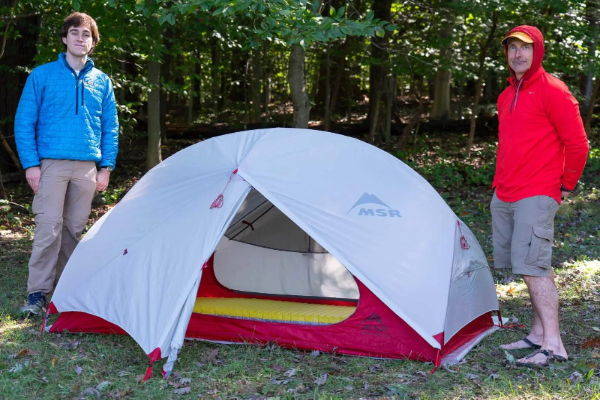When planning outdoor adventures, a good waterproof tent is essential. Staying dry and comfortable is key whether you’re hiking, camping, or backpacking. This guide will detail what makes a waterproof tent effective, highlighting important features to consider.
Understanding Waterproof Ratings
Waterproof tents come with ratings indicating their performance in wet conditions. The most common measurement is the hydrostatic head, which is measured in millimeters.
Hydrostatic Head: This rating tells you how much water pressure the fabric can withstand before leaking. A tent with a rating of 1,500mm is suitable for light rain, while one rated at 3,000mm or higher is better for heavy downpours.
Rainfly: Look for tents with a separate rainfly made from durable, waterproof materials. This additional layer helps keep water out.
Tent Fabric Types
The fabric of the tent plays a crucial role in waterproofing.
Nylon: Lightweight and commonly used, nylon tents often have a silicone or polyurethane coating for added waterproofing.
Polyester: This fabric is more UV-resistant than nylon but tends to be heavier. Look for polyester tents with waterproof coatings for better protection.
Canvas: While heavy, canvas tents provide excellent breathability and durability. They require a waterproof treatment but can be a great option for extended trips.
Tent Construction Features
The way a tent is constructed affects its waterproof capabilities.
Seams: Taped or welded seams help prevent leaks. Make sure the tent’s seams are well-sealed.
Floors: A tent with a bathtub floor design raises the edges, preventing water from pooling inside. Look for a durable, waterproof material for the tent floor.
Ventilation: Good airflow reduces condensation, which can lead to water inside the tent. Look for tents with vents or mesh panels.
Size and Weight Considerations
The size and weight of a tent are essential, especially for backpackers.
Capacity: Choose a tent that fits your group size comfortably. It’s better to have extra space than to feel cramped.
Weight: For backpacking, look for lightweight tents. A two-person tent should ideally weigh under four pounds. Check for ultralight options if you’re counting every ounce.
Setup and Portability
A good tent should be easy to set up, even in adverse weather.
Pole Design: Freestanding tents are easier to pitch and can be moved after setup. Look for color-coded poles for quick assembly.
Pack Size: Ensure the tent packs down small for easy transport. Most tents will fit in a standard backpack.
Price vs. Quality
Price often reflects quality.
Budget Options: If you’re on a tight budget, look for tents with good reviews, even if they lack some premium features. Brands like REI and Coleman offer reliable budget-friendly options.
Higher-End Tents: Investing in a more expensive tent often yields better materials, waterproof ratings, and durability. Brands like Big Agnes, MSR, and Hilleberg are known for high-quality tents.
Seasonal Considerations
Consider when and where you’ll be camping.
3-Season Tents: These are versatile and suitable for spring, summer, and fall camping. They typically handle light snow but are not designed for harsh winter conditions.
4-Season Tents: Built for extreme weather, these tents have stronger poles and more robust materials. They are ideal for winter camping or high-altitude expeditions.
Accessories for Enhanced Waterproofing
Certain accessories can improve your tent’s waterproof performance.
Footprint: A footprint is a groundsheet that adds an extra layer of protection for your tent floor. It helps prevent wear and tear and provides additional waterproofing.
Seam Sealer: Use seam sealer on the seams of your tent to enhance waterproofing. This is especially useful for older tents.
Top Waterproof Tent Recommendations
Here are some highly-rated waterproof tents to consider:
Big Agnes Copper Spur HV UL2: A lightweight, two-person tent with excellent waterproof ratings. It’s freestanding and easy to set up.
MSR Hubba Hubba NX: This versatile tent offers great space and ventilation. It’s suitable for various conditions.
REI Co-op Half Dome SL 2+: An affordable, spacious option that’s well-reviewed for its waterproof features and durability.
Maintenance Tips for Waterproof Tents
Proper care can extend the life of your tent.
Clean Regularly: After each trip, clean your tent with mild soap and water. Avoid harsh chemicals that can damage waterproof coatings.
Store Dry: Always store your tent dry to prevent mold and mildew.
Re-treat Waterproof Coating: Over time, the waterproof coating can wear off. Use a spray-on treatment to reapply waterproofing as needed.
Conclusion
Choosing a good waterproof tent is vital for a successful outdoor experience. Consider factors like waterproof ratings, fabric types, and tent construction. With proper care and maintenance, a quality waterproof tent can provide comfort and protection on many adventures. Whether you opt for a budget model or invest in a premium tent, ensure it meets your specific needs for your outdoor journeys.
Related topics:

